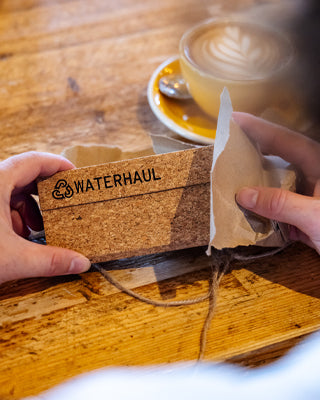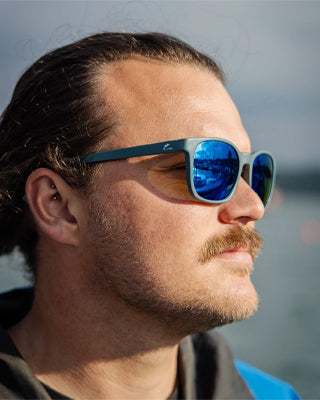Net Missions: Bullslaughter Bay, Pembrokeshire
WATERHAUL STORIES
SEAFOAM SNOW, GOLDEN HOUR AND 120KG OF BEACH PLASTIC
Bull slaughter bay or bull’s laugher bay?
Whilst carrying out one of our favourite net mission planning activities (scouring aerial images of the coastline to see where looks prime for nets to get snagged up on the beach) we came across the name ‘Bullslaughter Bay’ and so the debate over the real pronunciation of the name began.
We were in Pembrokeshire working on a new project, Recycle Môr, in partnership with the SeaTrust and after two days filming, we decided it was time to hit the beach for a net collection mission.
We’d heard that Bullslaughter Bay was a prime spot to find fishing nets and plastic pollution, and so armed with two wheelbarrows, a beach trolley, some Waterhaul beach cleaning knives, nine enthusiastic pairs of hands and two quartets of paws (aka Moss and Chip, our furry companions for the day) we were off to see what this beach had in store for us. It’s safe to say that the south-eastern tip of Wales can get pretty chilly in December with a howling wind, but our excitement of exploring a new bay and getting some nets spurred us on.

©Jacques Boissevain Photography - Heading down to Bullslaughter Bay
Turning off the main coast path, we headed along a small track that ran down a valley to the beach, and from the top we spotted a pile of plastic and net toward the back of the beach. Some members of our team joked that someone had already done the hard work for us, but after many net missions and beach cleans, you realise that there is always a reason why someone who has gone to the effort of cleaning the beach ended up leaving it in a pile at the bottom of the path! The reason these fellow beach cleaners had left it soon became clear as we scrambled down the path that resembled nothing more than the bed of a small stream.

©Jacques Boissevain Photography - The pile of ‘pre-collected’ beach debris
Once on the beach we all set off exploring the dramatic rock formations, golden sand, arches and caves on the hunt for ghost gear and to see what else we could find. Hidden in the cracks between huge boulders we found small fishing buoys and floats. Within the fishing industry, buoys are defined as markers that are attached to the bottom and float on the surface, whereas floats are generally attached to nets to keep them at a specific depth in the water.


The caves at the back of beaches are always of interest to us as you never know what you’re going to find jammed up at the back. When we do find nets in them, we often find that they are so tangled from the continuous pounding of the waves that getting them out needs to be the main focus of the day. For these missions, we plan to have the maximum amount of time in the cave, giving us enough time to be well clear before the tide comes in.
Recycled Ocean Plastic Products
After deciding that we should leave these nets for another day, we emerged back out into the light to be hit by what looked like snow! As the waves and wind whip up the water, bubbles form on the surface creating sea foam, and with the wind blowing onshore, it really looked like it was snowing across the beach.
As we carried on scouring the beach for nets, the ‘snow’ turned to rain, but the sun then turned it on and we were treated to an early afternoon golden hour. The nets are often wrapped around rocks and trapped under boulders so it takes some problem solving to work out how to untangle them without having to cut through the whole net. Cutting sections away in an inevitable part of our beach cleaning process but we always aim to untangle by hand as much as possible first to be able to remove the maximum amount of net. Removing the larger nets definitely involves teamwork, but sometimes the snag is in such a tight spot that there’s not much the other person can do – the perfect excuse to sit back, relax and enjoy the view!


When looking for the positives when faced with beaches covered in plastic, one thing we always find is that you’ll find something useful to help you get all the rubbish you’ve collected back to the car. Whether that is a long piece of line to tie all the net together, or this time, in the form of fish boxes which we pulled behind us like sleds! One flaw in this plan though is that your optimism as to how much you can pull up that tiny track when stood happily at the bottom loading up your box is very different to how you feel when you are only half way up the first section with the whole trek back to the car to go!

©Jacques Boissevain Photography - 120kg of plastic removed from the beach
This plastic is now heading to the SeaTrust HQ where it will be sorted, maximising the amount that can be reused, repurposed and recycled. As for the team? We’re off to warm up, refuel and get planning our next adventure!
10% OFF YOUR FIRST ORDER
Join our NETwork for events, all things ocean conservation and exclusive private sale launches


